Oil lubrication is suitable for applications requiring that bearing-generated heat or heat applied to the bearing from other sources be carried away from the bearing and dissipated to the outside.
1, Bearing oil lubrication methods
The choice of the oil lubrication method depends mainly on:
- The bearing speed
- The need to remove heat
- The need to remove contaminants (solid particles or liquid)
1.1, Oil bath lubrication
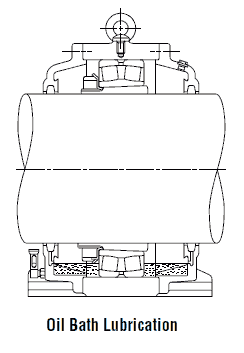 Oil bath lubrication is a widely used with low or medium speeds. The oil level should be at the center of the lowest rolling element. It is desirable to provide a sight gauge so the proper oil level may be maintained.
Oil bath lubrication is a widely used with low or medium speeds. The oil level should be at the center of the lowest rolling element. It is desirable to provide a sight gauge so the proper oil level may be maintained.
1.2, Drip-feed lubrication
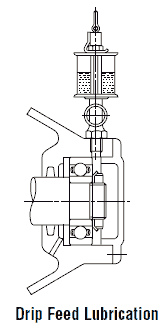 Drip feed lubrication is widely used for small ball bearings operated at relatively high speeds. Oil is stored in a visible oiler. The oil drip rate is controlled with the screw in the top.
Drip feed lubrication is widely used for small ball bearings operated at relatively high speeds. Oil is stored in a visible oiler. The oil drip rate is controlled with the screw in the top.
1.3, Splash lubrication
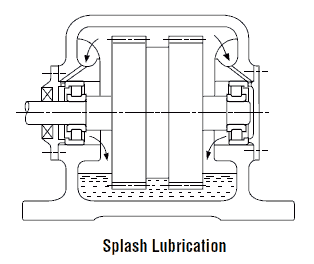 With this lubricating method, oil is splashed onto the bearings by gears or a simple rotating disc installed near bearings without submerging the bearings in oil. It is commonly used in automobile transmissions and final drive gears.
With this lubricating method, oil is splashed onto the bearings by gears or a simple rotating disc installed near bearings without submerging the bearings in oil. It is commonly used in automobile transmissions and final drive gears.
1.4, Circulating lubrication
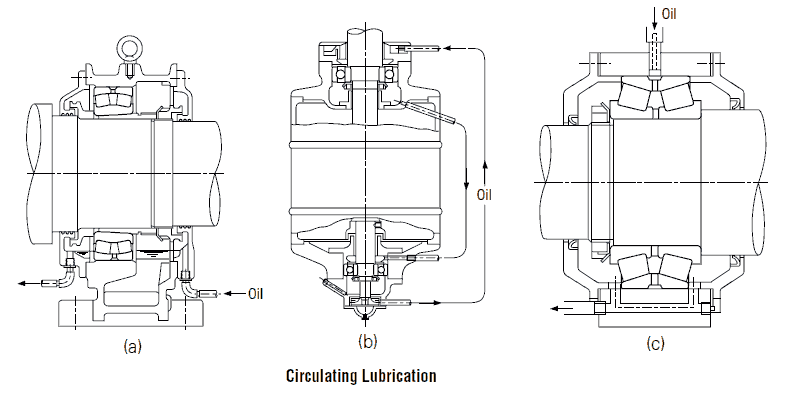
Circulating lubrication is commonly used for high speed operation requiring bearing cooling and for bearings used at high temperatures. As shown in picture above (a), oil is supplied by the pipe on the right side, it travels through the bearing, and drains out through the pipe on the left. After being cooled in a reservoir, it returns to the bearing through a pump and filter. The oil discharge pipe should be larger than the supply pipe so an excessive amount of oil will not back up in the housing.
1.5, Jet lubrication
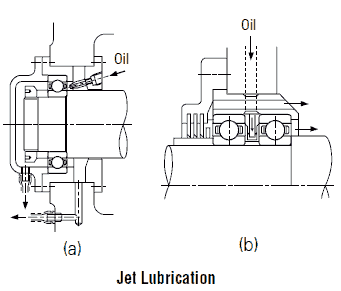 Jet lubrication is often used for ultra high speed bearings, such as the bearing in jet engines with dmn value exceeding one million. Lubrication oil is sprayed under pressure from one or more nozzles directly into the bearing.
Jet lubrication is often used for ultra high speed bearings, such as the bearing in jet engines with dmn value exceeding one million. Lubrication oil is sprayed under pressure from one or more nozzles directly into the bearing.
The picture shows an example of ordinary jet lubrication. The lubricating oil is sprayed on the inner and cage guide face. In the case of high speed operation, the air surrounding the bearing rotates with it causing the oil jet to be deflected. The jetting speed of the oil from the nozzle should be more than 20% of the circumferential speed of the inner ring outer surface (which is also the guide face for the cage).
More uniform cooling and a better temperature distribution is achieved using more nozzles for a given amount of oil. It is desirable for the oil to be forcibly discharged so the agitating resistance of the lubricant can be reduced and the oil can effectively carry away the heat.
1.6, Oil mist lubrication
Oil mist lubrication, also called oil fog lubrication, utilizes an oil mist sprayed into ta bearing. This method has the following advantages:
- Because of the small quantity of oil required, the oil agitation resistance is small, and higher speeds are possible.
- Contamination of the vicinity around the bearing is slight because the oil leakage is small.
- It is relatively easy to continuously supply fresh oil; therefor, the bearing life is extended.
This lubricating method is used in bearings for the high speed spindles of machine tools, high speed pumps, roll necks of rolling mills, tec.
1.7, Oil/Air lubricating method
Using the oil/air lubricating method, a very small amount of oil is discharged intermittently by a constant-quantity piston into a pipe carrying a constant flow of compressed air. The oil flows along the wall of the pipe and approaches a constant flow rate.
The advantages of oil/air lubrication are:
- Since the minimum necessary amount of oil is supplied, this method is suitable for high speeds because less heat is generated.
- Since the minimum amount of oil is fed continuously, bearing temperature remains stable. Also, because of the small amount of oil, there is almost no atmospheric pollution.
- Since only fresh oil is fed to the bearings, oil deterioration need not be considered.
- Since compressed air is always fed to the bearings, the internal pressure is high, so dust, cutting fluid, etc. cannot enter.
Selection of lubricating oil
Under normal operating conditions, spindle oil, machine oil, turbine oil, and other mineral oils are widely used for the lubrication of rolling bearings. However, for temperatures above 150°C or below -30°C, synthetic oils such as diester oil, silicone oil, and fluorocarbon oil are used.
For lubricating oils, viscosity is one of the most important properties and determines an oil's lubricating efficiency. If viscosity is too low, formation of the oil film will be insufficient, and damage will occur to the raceways of the bearing. If viscosity is too high, viscous resistance will also be great and result in temperature increases and friction loss. In general, for higher speed applications a lower viscosity oil should be used; for heavier load applications, a higher viscosity oil should be used.
In regard to operating temperature, Table below lists the required oil viscosity for different types of rolling bearings.
| Bearing type | Kinematic viscosity mm2 /s |
|---|---|
| Ball bearings, Cylindrical roller bearings, Needle roller bearings | 13 |
| Spherical roller bearings, Tapered roller bearings, Needle roller thrust bearings | 20 |
| Self-aligning roller thrust bearings | 30 |
The fig below is an oil viscosity - operating temperature comparison chart for the purpose of selecting a lubrication oil with viscosity characteristics appropriate to an application.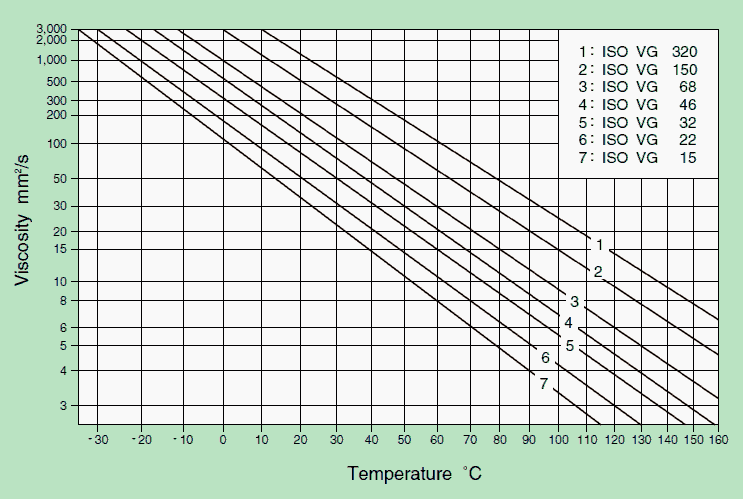
The table below lists the selection standards for lubricating oil viscosity with reference to bearing operating conditions.
| Bearing operating temperature °C | dn-value | Lubricating oil ISO viscosity grade (VG) | Suitable bearing | |
|---|---|---|---|---|
| Normal load | Heavy load or shock load | |||
| -30~ 0 | Up to allowable rotational speed | 22, 32 | 46 | All types |
| 0~ 60 | Up to 15,000 | 46, 68 | 100 | All types |
| 15,000 ~80,000 | 32, 46 | 68 | All types | |
| 80,000 ~150,000 | 22, 32 | 32 | All types but thrust ball bearings | |
| 150,000~500,000 | 10 | 22, 32 | Single row radial ball bearings, cylindrical roller bearings | |
| 60~100 | Up to 15,000 | 150 | 220 | All types |
| 15,000 ~80,000 | 100 | 150 | All types | |
| 80,000 ~150,000 | 68 | 100, 150 | All types but thrust ball bearings | |
| 150,000~500,000 | 32 | 68 | Single row radial ball bearings, cylindrical roller bearings | |
| 100 ~150 | Up to allowable rotational speed | 320 | All types | |
| 0~ 60 | 46, 68 | Self-aligning roller bearings | ||
| 60~100 | 150 | |||
